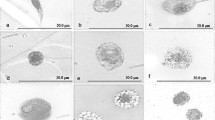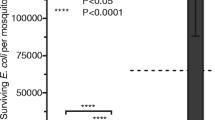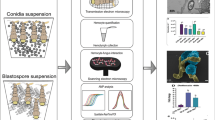Summary
The adherence of zoospores of Lagenidium giganteum to the cuticle of mosquito larvae is the initial step in the infection process. Subsequently, a germ tube penetrates the integument, inducing a rapid melanization of the injured cuticle and epidermis. After entering the hemocoel the developing hyphae are occasionally encapsulated locally. This process is slow (6 to 12 h postincubation) and most frequently cell-free, although it can be mediated by circulating hemocytes. Sporadic hemocyte mediation of the humoral encapsulation process in larval stages of Culicidae adds a previously unreported dimension to this unusual type of defense reaction. The defense reactions of larvae of Aedes aegypti were ineffective against observed infection by Lagenidium giganteum.
Similar content being viewed by others
References
Bronskill JF (1962) Encapsulation of rhabditoid nematodes in mosquitoes. Can J Zool 40:1269–1275
Carver M, Woolcock LT (1985) Interactions between Acyrthosiphon kondoi (Homoptera, Aphidoidea) and Aphelinus asychis (Hymenoptera, Chalcidoidea) and other parasites and hosts. Entomophaga 30(2): 193–198
Charles JF, Nicolas L (1986) Recycling of Bacillus sphaericus 2362 in mosquito larvae: a laboratory study. Ann Inst Pasteur Microbiol 137B:101–111
Christensen BM, Forton KF (1986) Hemocyte-mediated melanization of microfilariae in Aedes aegypti. J Parasitol 72 (2): 220–225
Collins FH, Sakai RK, Vernick KD, Paskewitz S, Seeley DC, Miller LH, Collins WE, Campbell CC, Gwadz RW (1986) Genetic selection of a Plasmodium-refractory strain of the malaria vector Anopheles gambiae. Science 234:607–610
Domnas A, Giebel PE, McInnis T (1974) Biochemistry of mosquito infection: Preliminary studies of biochemical change in Culex pipiens quinquefasciatus following infection with Lagenidium giganteum. J Invertebr Pathol 24:293–304
Esslinger JHY (1962) Behaviour of microfilariae of Bruggia pahangi in Anopheles quadrimaculatus. Am J Trop Med Hyg 1:749–758
Forton KF, Christensen BM, Sutherland DR (1985) Ultrastructure of the melanization response of Aedes trivittatus against inoculated Dirofilaria immitis microfilariae. J Parasitol 71 (3): 331–341
Götz P (1969) Die Einkapselung von Parasiten in der Hämolymphe von Chironomus Larven (Diptera). Zool Anz [Suppl] 33:610–617
Götz P (1986a) Encapsulation in arthropods. In: M. Brehélin (ed) Immunity in Invertebrates. Springer, Berlin Heidelberg New York, pp 153–170
Götz P (1986b) Mechanisms of encapsulation in Diptera hosts. In: A Lackie (ed) Immuno-mechanisms in invertebrate vectors. Symp Zool Soc Lond 56:1–19
Götz P, Vey A (1974) Humoral encapsulation in Diptera (Insecta): Defence reactions of Chironomus larvae against fungi. Parasitology 68:193–205
Götz P, Boman HG (1985) Insect immunity. In: Kerkut GA, Gilbert LI (eds) Comprehensive Insect Physiology, Biochemistry and Pharmacology, vol. 3. Pergamon Press, Oxford, pp 453–485
Götz P, Roettgen I, Lingg W (1977) Encapsulement humoral en tant que réaction de défense chez les Diptères. Ann Parasitol Hum Comp 52:95–97
Iwama R, Ashida M (1986) Biosynthesis of prophenoloxidase in hemocytes of larval hemolymph of the silkworm, Bombyx mori. Insect Biochem 16:547–555
Kerwin JL, Washino RK (1983) Sterol induction of sexual reproduction in Lagenidium giganteum. Exp Mycol 7:109–115
Nappi AJ, Christensen BM (1986) Quantitative analysis of hemolymph monophenol oxidase activity in immune reactive Aedes aegypti. Dev Comp Immunol 10:623
Nayer JK, Knight JW (1987) Innate immune response of the mosquito Anopheles quadrimaculatus, against the filarial nematode of Brugia sp. Abstracts SIP XX Annual Meeting:55–56
Nayer JK, Young MD, Forrester DJE (1981) Plasmodium hermani: Experimental transmission by Culex salinarius and comparison with other susceptible Florida mosquitoes. Exp Parasitol 51:431–437
Poinar GO Jr, Leutenegger R (1971) Ultrastructural investigation of the melanization process in Culex pipiens (Culicidae) in response to a nematode. J Ultrastruct Res 36:149–158
Ravallec M (1987) Recherches sur le potentiel larvicide d'Hyphomycètes entomopathogènes à l'égard des diptères Aedes albopictus (Skuse 1981) et Toxorhychites amboinensis (Doleschall 1857). Thèse de Doctorat de l'Université Paris VI, p 116
Soares GG Jr (1982) Pathogenesis of infection by the hyphomycetous fungus Tolopocladium cylindrosporum Grams, in Aedes sierrensis and Culex tarsalis (Dip. Culicidae). Entomoghaga 27(3): 283–300
Sweeney AW (1981) Fungal pathogens of mosquito larvae. In: Davidson E (ed) Pathogenesis of invertebrate microbial diseases. Allanhed, Osmun, Totowa, NJ USA, pp 403–424
WHO (1985) Data sheet for the biological control agent: Lagenidium giganteum. Document WHO/VBC/79.753, first revised edition
Author information
Authors and Affiliations
Rights and permissions
About this article
Cite this article
Brey, P.T., Lebrun, R.A., Papierok, B. et al. Defense reactions by larvae of Aedes aegypti during infection by the aquatic fungus Lagenidium giganteum (Oomycete). Cell Tissue Res. 253, 245–250 (1988). https://doi.org/10.1007/BF00221760
Accepted:
Issue Date:
DOI: https://doi.org/10.1007/BF00221760




